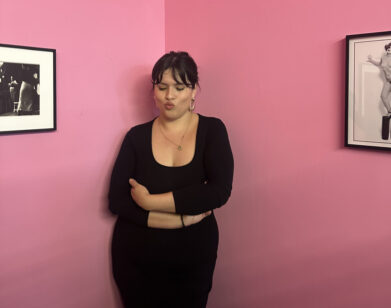Filling in the Dots: Tauba Auerbach

Tauba Auerbach’s dizzying, opt-art minded work draws influence from many sources, from the stark graphic designs of Alexander Girard to Guy de Cointet’s linguistic musings. Working across a variety of mediums, her current show of large-scale paintings, photographs and sculpture, Here and Now/And Nowhere at Deitch Projects, has a grand white elephant as its centerpiece. It’s a two-person pump organ, which, dressed as cult priestesses, Auerbach and her friend Cameron Mesirow (aka Glasser) played to a rapt audience of a few hundred people during the show’s opening. Auerbach and Mesirow designed the instrument, which like all proper white elephants is for sale (when the organ sells, a second one will be crafted for the artists’ personal use).
Six “fold” paintings on the gallery’s opposing wall are arranged to mimic the rising peak of the organ’s pipes, a reminder of the overlap of the visual and auditory. If ever a gallery echoed a chapel, Auerbach’s current show conjures a certain sanctity, a contemplative space for image and sound. (PHOTO: N DASH; DRESS DESIGNS BY IDA FALCK OEIEN)
Earlier this year at nearby Team Gallery, viewers buzzed about Cory Arcangel’s video “Arnold Schoenberg, op. 11–I–Cute Kittens” a ribald piss-take on the Viennese composer’s signature atonal style reduced to hiccups of piano plunking. Unlike that desultory stab at avant-gardism, Auerglass (as the organ is known) is a remarkable platform for creation, a genuine attempt to make music not pick it a part. What emerges from the wooden pipes of Auerglass are hauntingly dissonant nocturnes, one part Philip Glass, two parts György Ligeti with a dash of Steve Reich’s “Piano Phase” thrown in for good measure. The music likewise results from their cooperation: one cannot play this instrument without a second player. Although the organ is an analog instrument, their original composition intimates a digital-like sound. Similarly, manual elements like hand-touched Ben-Day dots, ironed creases on canvas, and 35mm-film television screenshots of static produce a cumulative digital sheen to the work hung on the walls. (Performances Tues-Sat at 5pm daily until 17 October).
STEVE PULIMOOD: In the early 1960s Lee Friedlander made several photographs of television sets. For me that series looks like stills from horror films, or at the least images of life perverted by the incessant slipstream of mass media. I was reminded of them because I thought that your photographs of television static were somewhat disturbing… Did you grow up too close to the TV?
TAUBA AUERBACH: No not at all. I was only allowed to watch PBS for a long time. Then at some point I begged my parents for cable so I could watch Nickelodeon.
See the full article and interview in Art in America.






